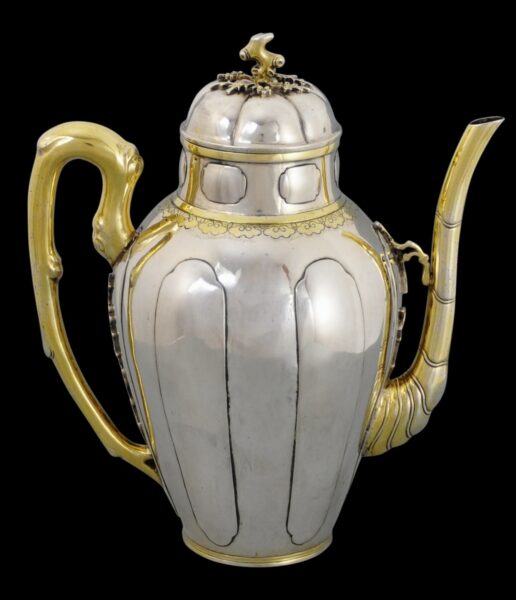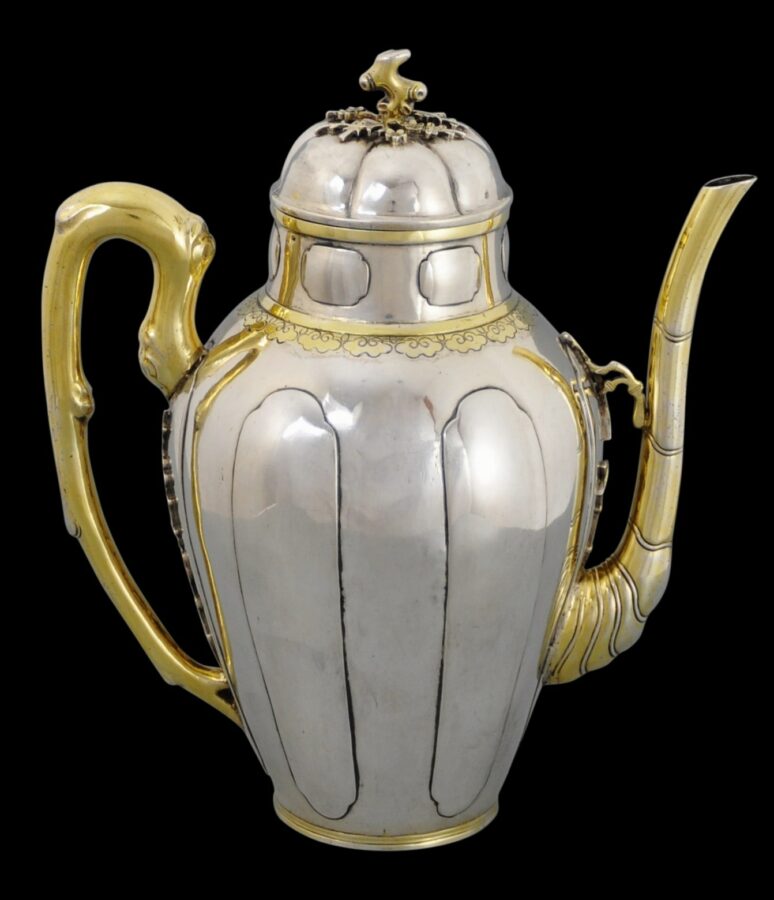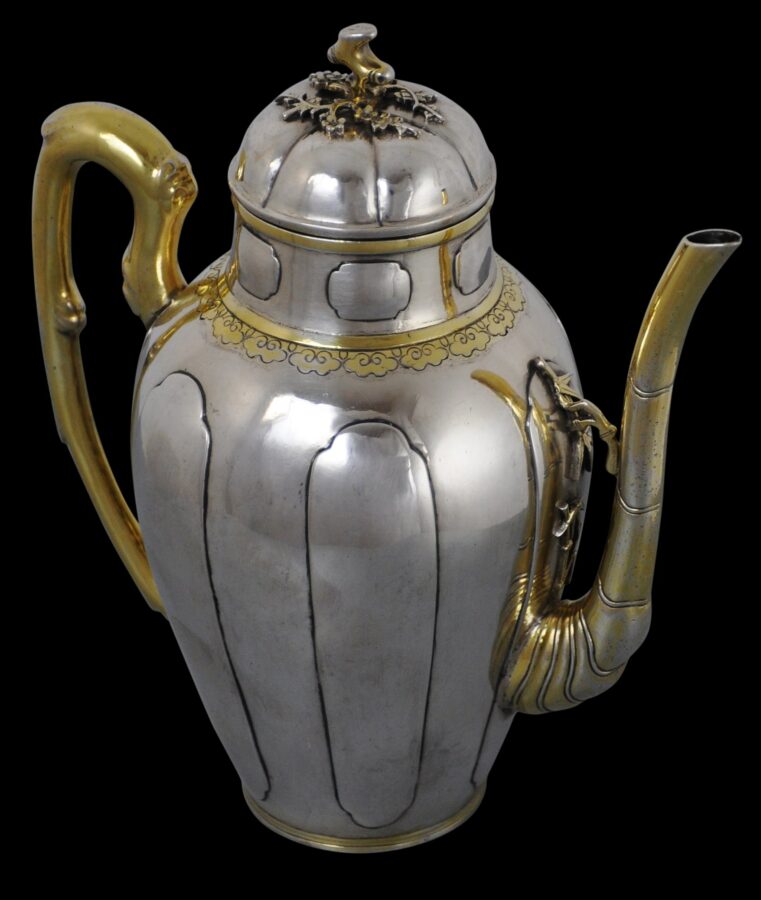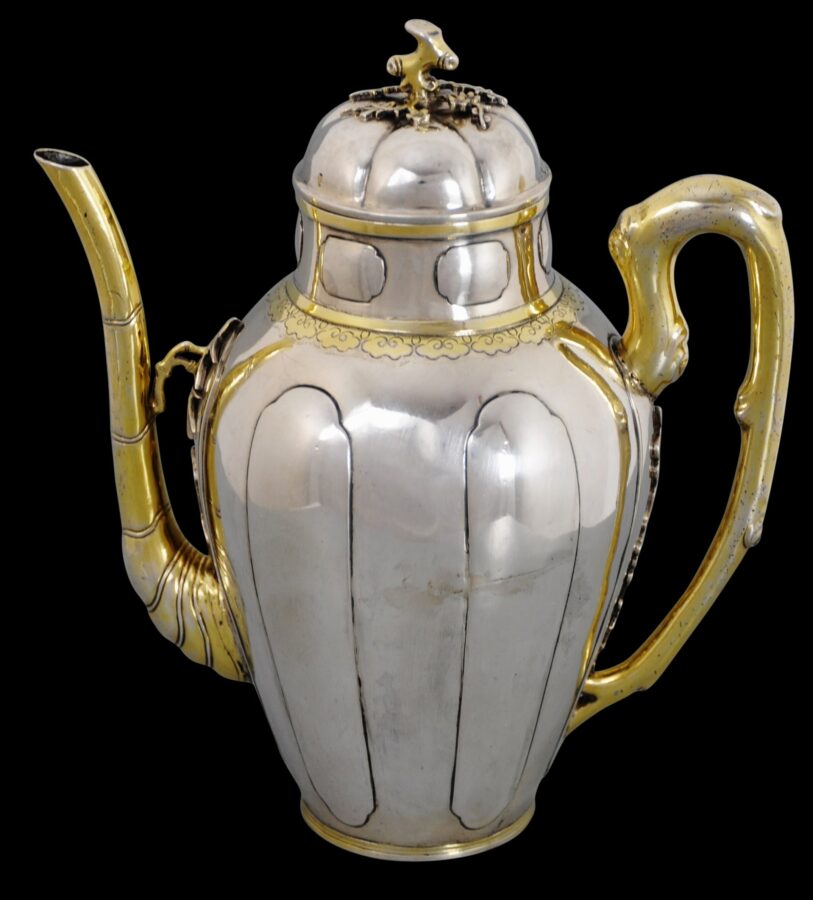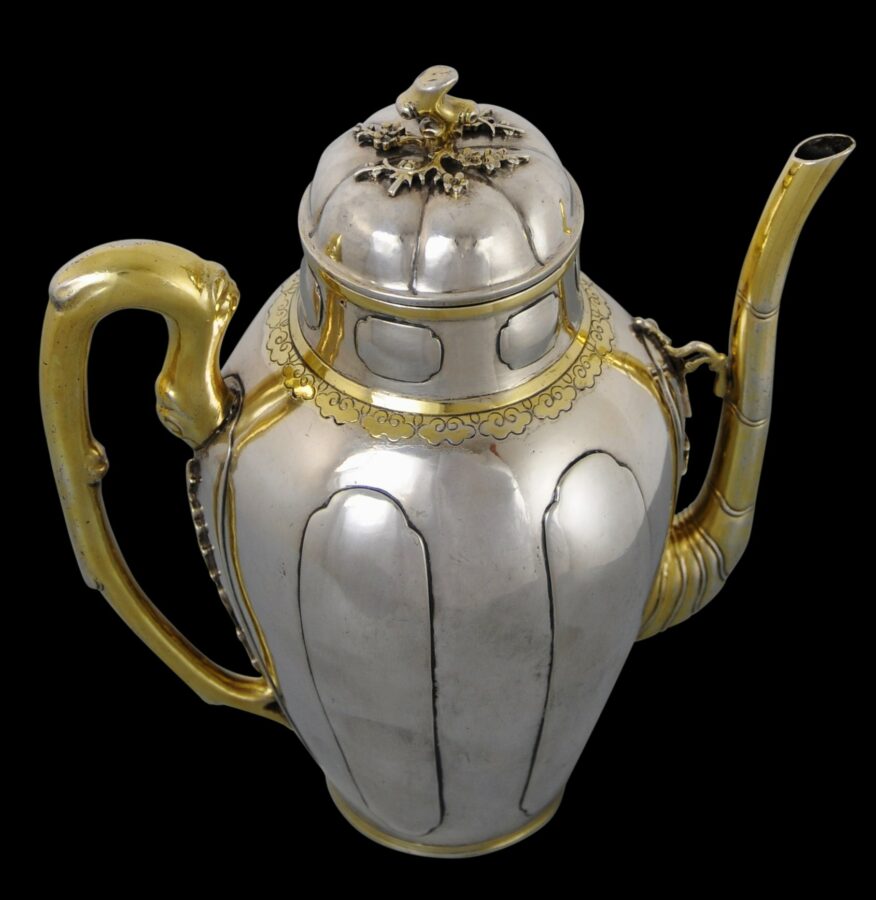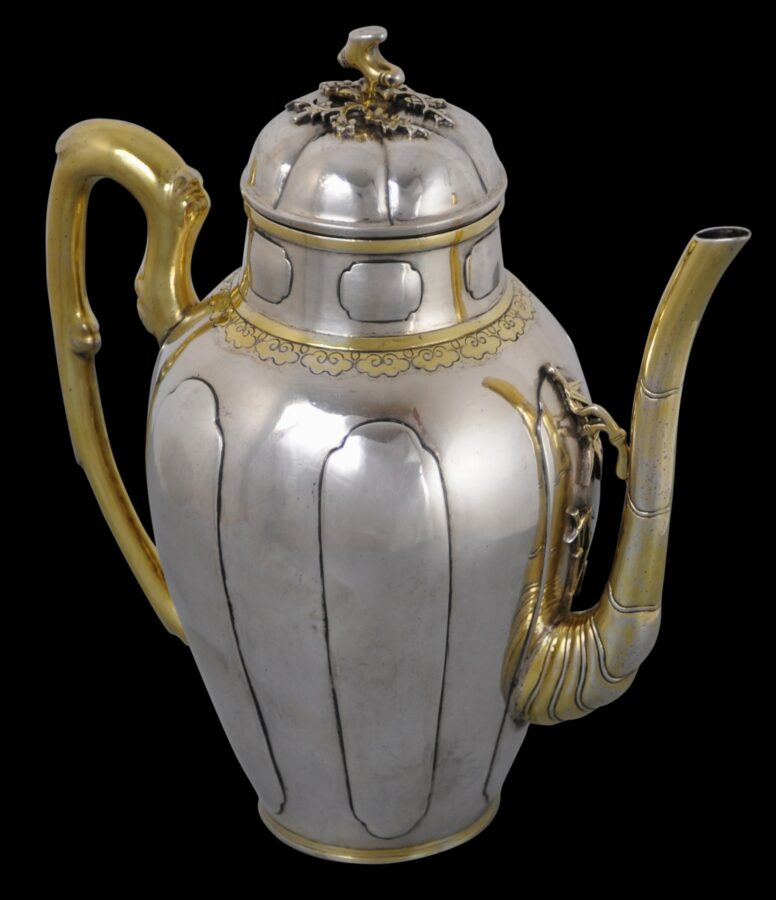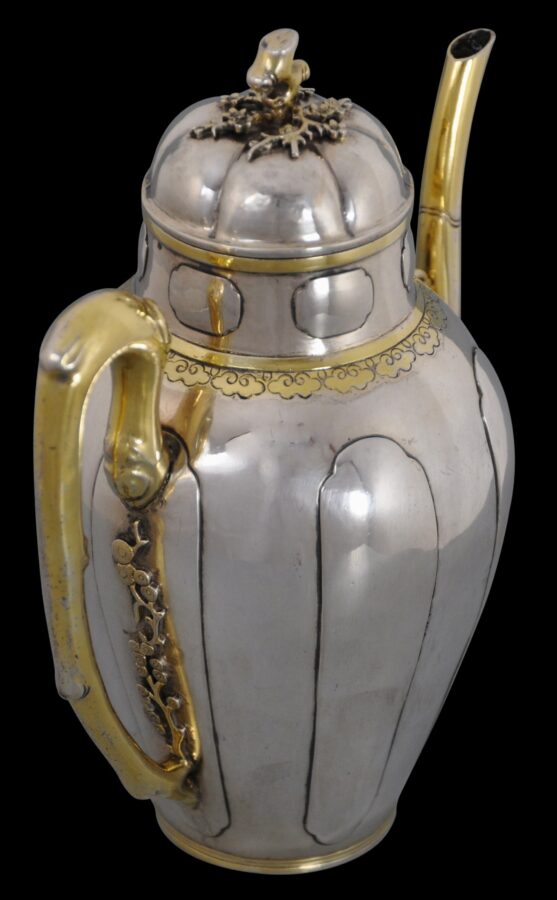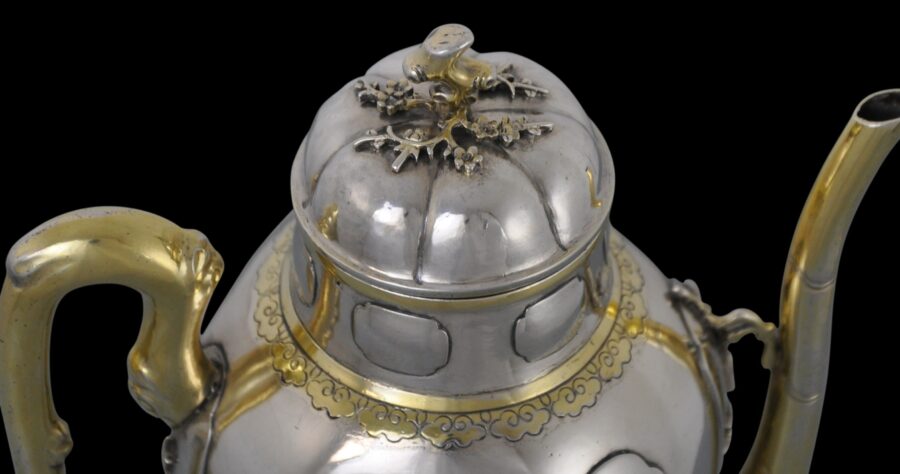Enquiry about object: 9081
Rare Southeast Asian (Batavian) or Chinese Parcel-Gilt Wine Ewer
Southeast Asia, possibly Batavia, or China circa 1680-1750
height: 17cm, length (from handle to spout): 15cm, weight: 415g
Provenance
UK art market; Sotheby's New York
This elegant and refined, six-lobed silver ewer with parcel gilding (part gold plating) dates to the 18th century and possibly to the 17th century. The form of the body appears based on an elongated gourd. The handle, which is gilded, is shaped like a gnarled branch. The spout, also gilded, is shaped as bamboo. The lid is shaped like a pumpkin and has a finial like a gnarled plum blossom branch segment surrounded by sprays of blossoms, which match a blossom-filled twig that runs up the vessel beneath the handle.
The ewer has various markings which reflect its interesting history. It was not marked when it was made but in its later life, its travels have been recorded with various assay, import and other marks.
The base is marked with the Chinese ideogram 同泰 . This transliterates as ‘Tong Tai’. The base body and the lid also have later Dutch import tax marks of a crowned V (used 1814-1893), the French import mark ‘ET’ for Paris 1864-93, and an Austrian import mark for Vienna 1902-18.
It has been suggested that the Tong Tai mark is for the Tongtai hong, or trading house, which was established by a Cantonese entrepreneur known as Poonequa (his actual Chinese name was Mai Tong Tai) in 1811. This was the assertion of Sotheby’s New York when this actual vessel passed through its rooms, but this was done without offering any evidence that the mark on the base and the Cantonese hong were one and the same.
The Tongtai hong specialised in the trade of Chinese tea between China and Europe. By 1827, the firm was insolvent however. But it is possible that the firm acquired the ewer, by then already an antique, and sold it, or presented it, to its European customers as a tea pot (even though the form among Chinese was only ever used for wine.)
However, it is entirely possible – indeed likely – that the Tong Tai mark has nothing to do with the Tong Tai hong. Tong Tai is a relatively common name among Southeast Asia’s Chinese, and so the mark could well relate to a Southeast Asian maker. For that matter, there is no record of the Tong Tai hong having traded in silver or ever having marked its goods with its name much less any silver. Indeed, ‘Tong Tai’ is such a generic name among Chinese in southern China and the Chinese of Southeast Asia that without any corroborating evidence, it would be foolish to claim definitively that the Chinese mark on the base relates to the Tong Tai hong.
The ewer itself has Chinese elements but also is reminiscent of Dutch colonial silver, and so it is entirely possible that the ewer was not actually made in China but made by an overseas Chinese silversmithing community such as those in Batavia or Vietnam, and that the ewer was presented to a senior personage in China perhaps as tribute or as a diplomatic gift. The Dutch East India Company (VOC) which had its Asian headquarters in Batavia maintained a treasury of locally-made silver items that it drew upon whenever it needed presentation gifts for rulers and officials in Asia. The gifts were used to buy access, to cement relations, and to help with trade negotiations. There are elements of the ewer that also are reminiscent of 17th century Mughal silver work, (indeed, such small ewers in Mughal India were used not for wine so much as opium water) and again, it is likely that Mughal silverwork was influenced by European diplomatic gifts. And among the Southeast Asia localised Chinese such as the peranakan Chinese (also known as the Straits Chinese or babas and nonyas) of the Straits Settlements of Malacca, Penang and Singapore (there were also peranakan Chinese communities in Sumatra, Java, Sulawesi, Phuket and elsewhere) such ewers were used in wealthier households on the family altar to serve wine in small cups to the ancestors at important festival occasions. They were used well into the 20th century (see an example we have in stock, and also Ho, 1984, p. 157-158 and Khoo, 1996, p. 234 for examples.)
Importantly, the first European mark that appears on the ewer is a Dutch mark. This lends further credence that the ewer has its origins somewhere other than China such as the Dutch East Indies capital, Batavia.
The form of the ewer is similar to a wine ewer (erroneously described as a tea pot, and more truncated than the example here) in London’s Victoria & Albert Museum which is dated to circa 1680, and almost identical to an example in the museum at the Chateau de Versailles near Paris, which was presented by ambassadors of the King Narai of Siam to France’s King Louis XIV in 1686 (see Bromberg, 2019, p. 67 for an illustration). This suggests a dating for the example here to be possibly at least as early as the these examples. Interestingly too, the example presented by the Siamese ambassadors shows that the form was available in Southeast Asia in the 17th century. Often the Siamese or Thai example is attributed to China, and it might well have been a piece that was gifted to the Siamese who then re-gifted it to the French (this re-gifting of diplomatic gifts did happen). But equally, it might have been made in Southeast Asia. The main difference between the example here and the Versailles example is that the panels on the body of the Versailles example have applied gilded silver flowers, whereas our example is left plain, and so is more in the colonial Dutch style.
The form certainly follows that used by wealthier Straits or peranankan Chinese in their ancestor worship ceremonies as mentioned, but also that of the gilt and black sawasa ewers produced in various centres in Asia such as Batavia, Vietnam, southern China and Japan – items which were traded to Europe by the Dutch and the VOC in the 18th century. Known locally as sawasa, the work became known in Europe as Tonkinese work after Tonkin or Vietnam which is where the items were believed to have been made. An example of a six-lobed sawasa ewer of almost identical proportions to the ewer here is illustrated in de Bruijn (1998, p. 90).
In all probability, this is not a ewer produced in China, but was produced outside China, perhaps in Batavia, and as such is a rare example of Dutch colonial silverwork produced most probably by localised Chinese silversmiths. Again, this would account for the earliest import marks which are Dutch, and the non-China ‘feel’ of the piece.
The ewer is in excellent condition and is free of any dents. The gilding has over time developed a beautiful softness, providing a gentle contrast with the silver.
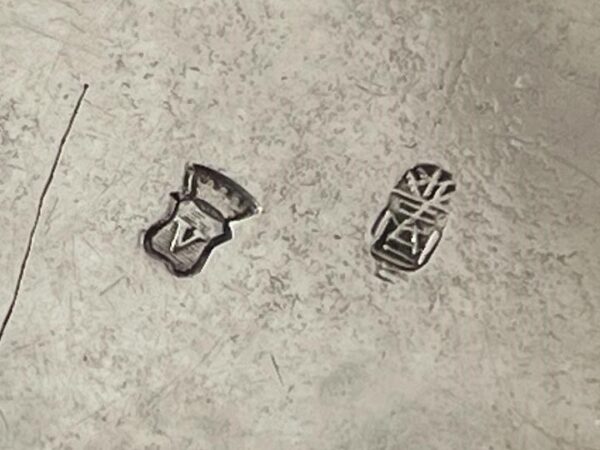
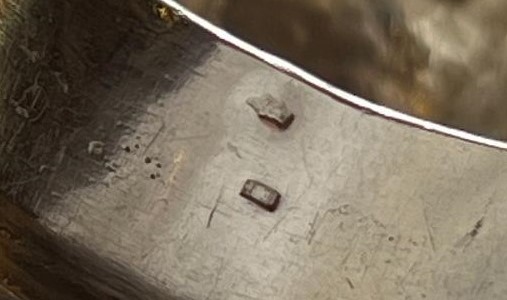
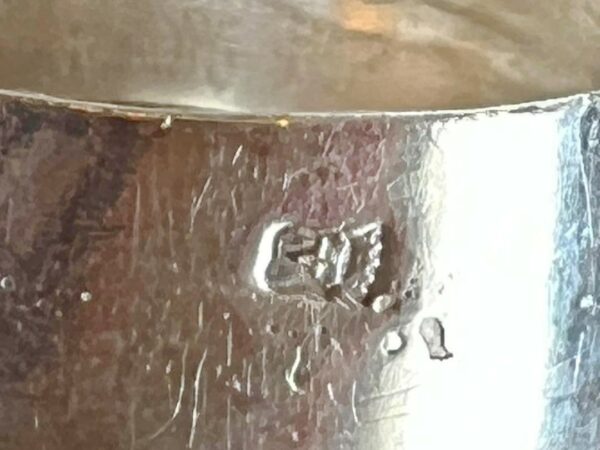
Above: some of the import & other marks that appear on the ewer.
Scroll down to see more images
References
Bromberg, P., Thai Silver and Nielloware, River Books, 2019.
de Bruijn, M., et al, Sawasa: Japanese Export Art in Black and Gold, 1650-1800, Rijksmuseum/Waanders Publishers, 1998.
Eliens, T.M., Silver from Batavia/Zilver uit Batavia, Gemeentemuseum Den Haag/W Books, 2012.
Forbes, H.A.C. et al, Chinese Export Silver 1785-1885, Museum of the American China Trade, 1975.
Grant, F.D., ‘The Chinese cornerstone of modern banking: the Canton guaranty system and the origins of bank deposit insurance 1780-1933’, dissertation, Leiden University, November 2012.
Ho, W.M., Straits Chinese Silver: A Collector’s Guide, Times International, 1984.
Khoo, J.E., The Straits Chinese: A Cultural History, The Pepin Press, 1996.


